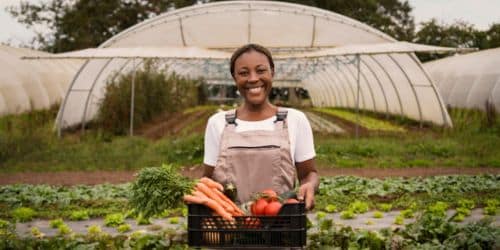Commercial farming is a complex and multifaceted topic with numerous areas to investigate. It’s a massive industry with a global reach and several ramifications for our society. This article will examine commercial farming from a variety of angles, including varieties, benefits, characteristics, and future estimates.
What is Commercial Farming?
Commercial farming is a type of agriculture in which crops or livestock are grown for profit. It differs from subsistence farming, in which farmers grow crops or raise cattle primarily for their own consumption. Commercial farming is a global enterprise with a wide range of operations.
Types Of Commercial Farming
Commercial farming is classified into numerous types. We can now proceed to investigate the various categories.
#1. Monoculture Farming
Monoculture farming is a farming practice in which a single crop is cultivated on the same site year after year. This might have both advantages and disadvantages. Monoculture farming, on the other hand, is simple to handle and can be quite productive. It can, however, contribute to soil degradation and increased susceptibility to pests and diseases.
#2. Rotational farming
Rotational farming involves planting different crops on the same plot of land on a regular basis. For example, a farmer may grow maize one year, legumes the next, and grasses the year after that. This technique allows the soil to restore nutrients while simultaneously disrupting insect and disease life cycles.
#3. Intensive Farming
Intensive farming is a style of farming that employs a high amount of inputs, such as fertilizers and pesticides, to maximize output. This style of farming is common in locations with a high population density and a strong demand for food.
#4. Livestock Farming
Livestock farming is a type of farming in which animals are raised for meat, milk, eggs, or other goods. This form of farming can be done on a small scale, like a family farm growing chickens for eggs, or on a huge one, like a factory farm raising thousands of pigs for pork.
What Commercial Crops Do Farmers Grow?
Commercial crops are those that are grown on a large scale with the intention of being sold for a profit. Corn is one of the world’s most extensively produced commercial crops.
Wheat is another popular commercial crop that is farmed extensively in the United States, Canada, Russia, and many other nations. Rice is another important commercial crop, with India, China, and the United States being major producers.
Commercial agriculture relies heavily on fruits and vegetables. Tomatoes are a popular crop, with the United States, China, and Italy producing the most.
Oranges, apples, bananas, and grapes are also common commercial fruits. Potatoes, onions, and carrots are among the most extensively produced crops in the world. Nuts, herbs, spices, and other food products are also popular commercial crops.
Characteristics Of Commercial Farming
There are numerous features that can be used to characterize commercial farming. Let’s take a look at seven of the most essential ones.
#1. Large Scale
Commercial farms, as previously said, are often significantly larger than conventional family farms. Because of the huge size, machinery and other technologies that can boost efficiency and productivity can be used. It also enables the use of economies of scale, which can reduce production costs per unit.
#2. Focus On Sales
This means that commercial farmers’ primary goal is not to feed themselves or their families. They are more concerned with growing crops that can be sold for a profit. These earnings can then be utilized to cover farm expenses as well as invest in new technologies and equipment.
#3. High Level Of Specialization
This means that commercial farms frequently grow only one or two crops. Because farmers can become specialists in the crops they raise, specialization allows for even greater efficiency and output. It also enables economies of scale because companies may concentrate on cultivating a particular crop in enormous quantities.
#4. Low Labor Costs
This is due to the fact that commercial farms frequently use machinery and automation to reduce the number of workers needed. In fact, many commercial farms employ only a few full-time workers, and they may only require seasonal staff during the planting and harvest seasons.
How to Begin a Commercial Farming Business
Starting a commercial farming business can be an exciting and gratifying endeavor, but it’s critical to understand the process.
#1. Create a Business Plan
Creating a business plan will assist you in determining your goals, budget, and marketing plan.
#2. Select a Location
The location of your farm will be critical to its success, so make an informed decision.
#3. Purchase or Lease Land and Equipment
For your farming operation, you’ll need to purchase or lease land as well as the essential equipment.
#4. Obtain Required Permits and licenses
Depending on the type of farming you intend to conduct, you may be required to obtain various permits and licenses.
#5. Choose Your Crops
The crops you cultivate will be determined by a variety of factors, including climate, soil type, and market demand.
#6. Establish Infrastructure
This includes things like irrigation, fencing, and storage facilities.
Considerations for Starting a Commercial Farming Business
A lot of elements must be carefully considered before starting a successful commercial agricultural enterprise.
#1. Market Demand
This relates to the level of demand for the things you intend to develop or create. To be successful, you must first ensure that there is a market for your products and that you can meet the demand.
#2. Climate
This relates to the weather conditions in the location where you intend to conduct business. Because different crops require different climates to thrive, it’s critical to select a location that will give the ideal conditions for the crops you intend to cultivate.
#3. Soil Quality
Because the soil serves as the basis for your crops, it is critical that it have the proper nutrients and qualities to enable healthy growth.
#4. Access to Water
This relates to the availability of water resources in the area where your firm will be located. You must ensure that there is adequate water to suit your crops’ needs as well as any other water requirements for your business.
#5. Availability of Labor
This relates to the labor availability in the location where you intend to conduct your firm. You must ensure that there is a sufficient labor force to suit your company’s needs, both in terms of number and quality.
The Benefits of Commercial Farming
Commercial farming provides numerous benefits over other methods of farming. Among these benefits are the following:
#1. Increased food production
Because of mechanized machinery and superior crop varieties, commercial farms may produce more food per acre than traditional family farms.
#2. Enhanced Efficiency
Because commercial farming utilizes less inputs to produce the same amount of crops as traditional family farming, it is more efficient. Because of economies of scale, the utilization of mechanized equipment, and other efficiency-enhancing technology, this is the case.
#3. Reduced Prices
One of the primary benefits of commercial farming is that it contributes to cheap food prices. This is because large-scale production allows for economies of scale, which lowers production costs per unit.
#4. More Eco-Friendly Practices
Commercial farming has numerous advantages in terms of sustainability. For one thing, it can aid in the conservation of natural resources by minimizing the quantity of water, fertilizer, and pesticides utilized.
#5. Improved Land and Water Resource Management
Commercial farms are frequently able to utilise these resources more efficiently than family farms. Furthermore, commercial farms may employ water-saving methods such as drip irrigation, which minimizes water consumption by delivering water straight to the root zone of the plants.
Challenges Of Commercial Farming
Challenges are an integral aspect of any enterprise, including commercial farming. The difficulties that commercial farmers encounter can have a significant impact on their capacity to succeed.
#1. Climate Change
Climate change poses a significant challenge to commercial farmers since it can result in unpredictable weather patterns and more catastrophic weather occurrences. These changes may have a negative influence on crop production, resulting in lower earnings and food shortages.
#2. Pest and Disease Management
Pests and diseases can wreak havoc on crops and cause severe damage. Commercial farmers must be aware of the hazards posed by pests and diseases and employ preventative and control measures. Pesticides and other management approaches may be used.
#3. Recruiting and Retaining Skilled Personnel
Commercial farming is a highly technological enterprise that necessitates the use of skilled employees to run machinery and maintain crops. However, finding and retaining these workers might be difficult because they may prefer to work in other industries or relocate to cities.
#4. Striking a Balance Between Profits and Social and Environmental Responsibility
Commercial farmers must make a profit in order to stay in business, but they must also consider the social and environmental implications of their operations. Commercial farmers, for example, must consider issues such as water and air pollution, soil erosion, and the health of neighboring people.
#5. Global Trade and Market Volatility’s Impact
To sell their crops, commercial farmers must traverse a complex global commerce system. Trade agreements, tariffs, and currency changes can all have an impact on this system.
Future of Commercial Farming
Commercial farming’s future is projected to involve many changes, owing to variables such as population expansion, climate change, and technological improvements. For example, we could witness a shift toward more sustainable farming practices like vertical farming or the use of gene editing to generate drought-resistant crops. As people become more conscious of the environmental consequences of meat production, we may see a trend toward more plant-based diets.
One future trend that we may witness is a shift toward more local farming, in which food is produced closer to where it is consumed. This could help lessen the environmental effect of transportation while also increasing the availability of fresh, seasonal produce. We may also see more urban farming, which involves growing crops in cities through vertical farming or hydroponics.
What is the Difference Between Subsistence Farming and Commercial Farming?
Commercial farming grows crops for profit, whereas subsistence farming grows crops for personal consumption. Subsistence farming is heavily influenced by the monsoon. Subsistence farming relies more on animals and human labor than traditional methods.
What are the Advantages and Disadvantages of Commercial Farming?
Hand labor was replaced by machine farming in commercial agriculture. This reality obscures the different benefits and drawbacks of commercial agriculture. On the one hand, it enhanced crop productivity; on the other hand, it created environmental risks.
What are the Factors Affecting the Success of Commercial Agriculture in Nigeria?
Poor infrastructure and market access, as well as insufficient supply chain management services, make it difficult for farmers to obtain appropriate inputs at acceptable costs.
Which Vegetable Farming is More Profitable in Nigeria?
Cucumber is one of the most profitable three-month crops that anyone in Nigeria can plant. Cucumber is known as the “money crop” by farmers in Nigeria because of its propensity to increase farm earnings. Cucumbers are in high demand in Nigeria’s cities and towns.
Which Crops Produce the Most Food?
Aside from sugar cane, which ranks first, the top three most produced crops in the world are all grains. Grains, which comprise cereals and legumes, are a common crop because they can grow in practically any climate.
Conclusion
Commercial farming is a complicated and difficult industry. Climate change, pests and illnesses, limited access to cash, skilled labor shortages, and negotiating the global trading system are all obstacles for commercial farmers. Commercial farmers must be able to adapt to these obstacles and find solutions that work for their individual operations in order to be successful. The industry is always changing, therefore, it’s critical to stay up-to-date on the latest trends and advances.
Having said that, commercial farming is an important component of the world’s food supply.
- How to Expand Agribusiness Using Satellite Imagery Analysis
- Banana Farming in Nigeria: Everything You Need To Know
- STARTING A BUSINESS IN TEXAS: Checklist, Costs, and Requirements
- AGRICULTURE COMPANY: Top Best Agriculture Companies of 2023
- Wheat Farming In Nigeria: All You Need To Know






